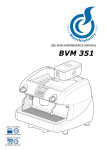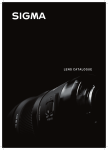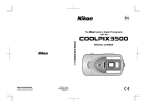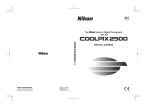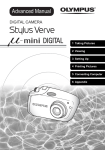Download Olympus 200 Digital Camera User Manual
Transcript
INSTRUCTIONS Table of contents Preparations before taking pictures AUTO-S flash mode . . . . . . . . . . . . . . . . . 25 Loading the batteries . . . . . . . . . . . . . . . . . 2 Simple operating procedures Flash OFF mode . . . . . . . . . . . . . . . . . . . . 28 FILL-IN flash mode ................. 29 Loading the film . . . . . . . . . . . . . . . . . . . . 4 Taking pictures . . . . . . . . . . . . . . . . . . . . . 7 MULTI flash mode . . . . . . . . . . . . . . . . . 31 Unloading the film . . . . . . . . . . . . . . . . . . 13 Using the remote control .............. 33 Use of fillers ....................... 36 Automatic flash activation Mounting the strap .................. 38 (1) Taking pictures in low light . . . . . . . . . . 15 Use of the optional Olympus case ........ 39 (2) Taking backlighted subjects .......... 18 Advanced shooting techniques Care and storage . . . . . . . . . . . . . . . . . . . . . . 40 Questions and answers .................. 42 Spot metering . . . . . . . . . . . . . . . . . . . . . . 19 Auto-zoom photography .............. 21 Description of controls . . . . . . . . . . . . . . . . . . 44 Taking a continuous scries of shots ....... 23 Viewfinder display and LCD panel .......... 46 Using the self-timer .................. 24 Specifications ........................ 47 • Please read this instruction manual carefully before using your camera. •This camera will not operate unless the barrier is opened. •Before taking important pictures such as on travels, it is recommended that you take trial pictures. 1 Preparations before taking pictures Remove the battery cover on the side of the grip. Insert the batteries in the correct directions and replace the cover. Two 3V lithium batteries (DL123A/CR123A) Loading the batteries Be sure to the correct batteries, and do not mix new and old batteries at the same time. Remove the batteries and keep them in a safe place if you are not likely to use the camera for long time. 2 Note: After inserting the batteries the Set the power switch to ON and check the charge remaining in the camera may activate electronically without having set the power switch to the ON position In this switch- batteries. Battery power will be displayed in the LCD panel. When is displayed for 12 sec., the batteries are OK. When blinks, it indicates that the battery power is low, and the batteries should be replaced. When lights, replace the batteries immediately. ON status, the barrier opens and the LCD panel is indicated The LCD panel will remain on for approximately 4, 5 minutes. 3 Simple operating procedures To open the back, slide the back cover lock up. Loading the film This camera is designed to use 35mm film with "DX" coding to automatically set film speed. If no "DX" film is available, use ISO-100 film. 4 The camera back will open. Insert the film cartridge into the camera. itself for DX-coded film speeds Always avoid direct sunlight when ranging from ISO 50 — 3200. (Refer loading the film. to Page 47.) • In case of non DX film, film speed is automatically set to ISO 100. Prepare a "DX" film cartridge. Your camera will automatically set 5 Make sure the film lies flat. Align the film leader with the red Close the camera back. mark. 6 You can check the type of film in Setting the power switch to ON, check that the exposure counter use through the window in the back of the camera. displays "1". • I f the film is not loaded properly, the exposure counter will not show "1" and a display as shown in the illustration will appear in the LCD panel In this case, reload the film correctly. Taking pictures When the power switch is on, the LCD panel lights. The LCD panel goes out after 4.5 minutes. Then the lens will zoom to the wide-angle position. 7 Set the power switch to ON, which will open the lens barrier. When the camera is not in use, always set the power switch to OFF so that the shutter cannot be activated by accident and the lens barrier will be closed to protect the lens. While looking through the When the power switch is set to ON, the barrier opens and the lens shifts viewfinder, aim the camera at the subject you want to shoot. out to the wide angle shooting position. 8 Operate the zoom button to adjust the lens until you see the image you want. When the T side of the zoom button When the W side of the zoom button is pressed, the lens will zoom to the is pressed, the lens will zoom to the telephoto side. wide-angle side. (In the telephoto position. the maxi- (In the wide-angle position, the mum focal length of the lens is minimum focal length of the lens is 38mm.) 80mm.) 9 Adjust the focus to position your subject within the multi autofocus frame. The multi autofocus system will focus the camera on the closest subject in the multi autofocus frame. Press the shutter release button light- As this camera has the multi ly and confirm that the autofocus indicator "AF" (green) lights in the viewfinder. The subject should be within the picture frame. 10 autofocus system built-in, correct focus is assured even in a composition like this when your subject is not centered in the viewfinder. The subject should normally be positioned within the picture frame. Shooting range: Autofocus operates with the subject However, if the subject is 0.6m (2 ft.) at a distance of 0.6m (2 ft) to (infinity). from the camera, the actual image area is reduced and the subject should be positioned within the close-up correction marks. Close-up correction marks for close range subjects. 11 If the subject is closer than 0.6m (2 ft), the "AF" indicator (green) blinks when the shutter is pressed lightly to warn that the picture will probably be out of focus. Note: the AF indicator may not blink when the subject is extremely close even though the picture will be out of focus. • The shutter can still be released even if the AF indicator blinks. Correct and incorrect ways to aim the camera: Be careful not to touch the lens or flash. When using a shoulder strap, be careful that the strap does not obstruct the lens or flash. When the lens needs to be cleaned, wipe it softly with lens cleaner and lens cleaning tissue. 12 Gently press the shutter release button. If you press the button too quickly, the camera may shake, causing blurred pictures. As soon as your finger is removed, the film automatically advances to the next frame. As the film advances one frame, the exposure counter advances to the next frame number. 13 Unloading the film When you reach the end of a roll of film, it is automatically rewound. You will hear the motor operating and the exposure counter will count back until it reads "E". The final reading of the exposure counter prior to rewinding may be more than the number of exposures specified for the film (24 or 36), as you may get 25 shots on a 24 exposure roll. 14 If you want to rewind the film before the end of the roll, push the rewind button using the lip of a ball point pen or other device having a small round lip. Do not use any device having a sharp pointed tip. Be careful not to press the rewind button with too much force. When rewinding is complete, the Remove the film from the camera. sound of the motor operating will stop and "E" will blink in the LCD panel. Open the camera back. • Once the rewinding is finished, the camera back must be opened before any other operations are possible. 15 Automatic flash activation (1) Taking pictures in low light If there is insufficient light, the Press the shutter release button fully flash indicator (orange) will light to take a picture. when the shutter release button is • While the flash is being charged, pressed lightly. If a picture-taking the flash indicator (orange) may situation is likely to result in the Red- not light and the flash may not fire. eye phenomenon," S" will blink It takes about 0.2 — 3.5 seconds in the viewfinder. Switch to the after the film is advanced to charge "AUTO-S" mode. (Refer to Page 25.) the flash (at normal temperatures). When the flash mode is set to AUTO, the flash will fire automatically when there is insufficient light 16 Flash working range: Color negative film will give you excellent pictures in this shooting range because it offers the widest exposure latitude, compensating for over and underexposure more readily than other films. ISO 100 400 WIDE (38mm) 0.6m-4.1m(2ft-13.5ft) 0.6m-8.2m (2ft-26.9ft) TELE (80mm) 0.6m-2.9m (2ft-9.5ft) 0.6m-5.8m(2ft-19ft) In the continuous shooting mode ISO 100 400 WIDE (38mm) 0.6m-2.9m (2ft-9.5ft) 0.6m-5.8m(2ft-19ft) 17 TELE (80mm) 0.6m-2m (2ft-6.6ft) 0.6m-4m (2ft-l3.1 ft) Automatic flash activation (2) Taking backlighted subjects If you are taking backlighted subjects, the flash indicator (orange) will light when the shutter release is depressed to tell you that the flash will fire automatically. Make sure to place the main part of your subject in the multi autofocus frame. 18 Advanced shooting techniques Spot metering This mode should be used when there exists an obstacle in front of the image in the multi autofocus frame or if the focusing object is out of the multi autofocus frame. This mode can also be used in situations where uneven lighting conditions exist. 19 Pressing the "SUBJECT" button. set the mode to "SPOT". "SPOT" will appear in the LCD panel. Press the shutter release button lightly, aiming at the image desired. Confirm that the "AF" indicator (green) in the viewfinder lights. (In this case, focusing is locked on the spot frame at the center. Exposure is also locked at the same time. Be careful to keep the subject inside the spot frame.) 20 Keeping the shutter release button pressed lightly, change the composition of the image as you want. Press the shutter release button fully to take the picture. Auto-zoom photography Use this mode to obtain photographs of portrait composition even when the distance to the subject changes. 21 Press the SUBJECT button to set the mode to . Working distances: Press the shutter release button. The zoom operates automatically to capture an above the waist portrait • Outside the ranges shown in the of a person before the shutter is illustrations below Auto-zoom released. may not function. • Even in the Auto-zoom mode it is possible to use the zoom button. 22 Press the SUBJECT button to set the mode to "C". "C" lights in the LCD panel The camera will shoot repeatedly as long as the shutter release button is depressed. • The autofocus and exposure will be reset instantly even when the subject is moving toward or away from the camera, and even when the light condition changes. Taking a continuous series of shots You can shoot continuously at a speed of 1 frame every approx. 1.7 seconds (1 frame every approx. 2.5 seconds when the flash is used. Refer to page 17 for the flash working range when in the continuous shooting mode.) 23 Press the SUBJECT button, and set the mode to lights in the LCD panel. Press the shutter release button lightly, and focus on the subject you want to shoot. When focused, the "AF" indicator (green) lights in the viewfinder. Using the self-timer The camera should be set firmly, on a tripod, for example. 24 Press the shutter release button fully to start the self-timer. The self-timer indicator lights and the shutter will be released in 12 seconds. The self-timer indicator will start blinking 2 seconds before the shutter is released. After the shutter is released, the self-timer mode will be released. (In case you want to cancel the selftimer function before the shutter is released, press the SUBJECT button, or set the power switch to OFF.) AUTO-S flash mode In this mode, the red-eye phenomenon which occurs mostly in compact type cameras will be minimized. Remarks: "Red-eye" is a phenomenon in which the pupil of the eye appears too red in pictures taken with a flash. 25 When " S" blinks in the viewfinder while the camera is in either the AUTO or FILL-IN modes, switch to the AUTO-S mode. The blinking " S" will disappear. Press the FLASH button to change the mode to AUTO-S. will light in the LCD panel. Pressing the shutter release button, a preparatory flash emission occurs before the shutter is released with the main flash emission. The preparatory flash emission produces a 26 flickering beam of light which "prepares" your subject's eyes by reducing pupil size. The main flash emission is the same as the normal auto flash emission. • Hold the camera steady while pressing the shutter release button until the shutter is released. • The AUTO-S mode is not cancelled by switching the power switch to OFF. To release the AUTO-S mode, press the FLASH AUTO-S flash mode working range. mode button. 27 Press the FLASH button to set the flash mode to OFF. • In low lighting conditions, the shutter speed may be slow (as long as 1 second). Use a tripod, etc., to prevent the effects of camera shake. Flash OFF mode Use this mode in a museum, etc., where flash photography is prohibited, or when you don't want the flash to fire, such as during the shooting of night scenes. 28 Press the FLASH button and set the flash mode to FILL-IN. FILL-IN flash mode In this mode, the flash always operates. Use this mode for daylight synchro photography or shooting backlit subjects. 29 With backlighting, the person's face etc., may be too dark. By using the FILL-IN mode, the subject will be properly lit by the flash. 30 Press the FLASH button and set the flash mode to MULTI. The flash will fire four times during one exposure. MULTI flash mode In the MULTI flash mode you can segment a motion sequence — such as a golf single shot. 31 The shutter speed is set to 1/6 set Use it in low light. If using it in a light place, the picture will be over-exposed. • Use a tripod, to prevent the effect of camera shake. Working range of the MULTI flash mode. 32 Using a coin, turn the screw to remove the remote control device from the camera. Using the remote control 33 When the remote control device been removed from the camera, blinks in the LCD panel The camera should be set firmly, on tripod, for example. While looking through the viewfinder, aim the camera at the subject you want to shoot. With the remote control device in your hand stand where the picture is to be taken, and press the transmitt- ing button on the device. • This remote control device is usable up to approx. 5m (16.4 ft) directly in front of the camera, and up to 3.5m (11.5 ft in a diagonal direction within 30° to the right or left. If you are not within the above range, use the self-timer instead. 34 The self-timer signal of the camera blinks. As soon as the blinking stops, the shutter is released The allowance time, after having pressed the transmitting button on the remote control device until the shutter is released, can be switched to either 1 sec. or 3 sec. 35 NOTE: The remote control device will be effective for approximately 20 minutes after removing it from the camera. • The remote control may not function in backlighting situations. • Remote control shooting can be combined with each camera mode. In the continuous shooting mode, however, you are limited to two shots. • The battery inside the remote control device cannot be changed; however, it is designed to last a minimum of eight years. After having finished using the remote control device, return it to the camera and lock it in place with a coin. Use of filters Special-effects can be obtained by using the optional Olympus Filter set. You can attach these filters to this camera by using the optional adaptor. 36 Olympus offers the following optional filters. (Filter diameter. 35.5mm) (1) Skylight Prevents a blue tone in color photographs taken on fair weather days and provides an overall more natural color lone. (2)Softon Use this for portraits; it softens the image for more "moody" pictures. (3) Sunny Cross The photograph will have rays of light around bright objects. When the Sunny Cross is used. When the Softon is used. 37 Mounting the strap How to put the strap on the camera Use of the optional Olympus case 38 How to use the case Mike sure to set the power switch to OFF before the camera is inserted into the case. 39 Care and storage Do not try to disassemble the Do not touch the DX readoff concamera yourself. Do not use tacts. Do not put used batteries thinner, benzen or organic solvents to into a fire and do not heat, disassemble or try short them. clean the camera. 40 Do not rotate the camera further once it is mounted on a tripod. Use tripod swivel to vary direction. Do not leave the camera near Do not expose the camera to extreme heat (over 50°C or 122°F), such as inside a car during the hot summer weather, or to extreme cold (below -10°C or 14°F). magnetic fields, like on top of a TV set, or radio. In case of malfunction, take the camera to your nearest Olympus dealer or repair center. 41 Questions and answers Q: What kind of battery should I use? A: Use two lithium Duracell DL-123A or two Panasonic CR123A batteries. Don't install one new battery with an old one. Change them both at the same time. Q: How long do the batteries last? A: Since long-life lithium batteries are used, approximately 30 rolls (24-exposure, half the shots with flash) can be taken. work until new film is inserted. Q: The camera does not focus correctly. What should I do? A: (1) In the following situations, the camera's autofocus mechanism may not function properly. Use the spot mode when taking the following pictures.(Refer to P. 19) Objects that reflect too much light Black objects Pictures taken through a glass window or wire screening Pictures including flames or smoke When the sun is included in the picture. When the frequency with which the flash and zoom are used is less, the batteries will last longer. (2) The Multi AF system built-in this camera shifts the measuring distance according to the focal distance as Q: The camera does not work. What should I do? A: (1) Make sure the power switch is set to ON. (2) Check to make sure that the batteries are loaded and inserted correctly. (3) If the film has been rewound, the camera won't shown in the illustration. In case there are any objects other than the primary subjects within range of this measuring distance, the camera may not focus on the subject. In such cases, use the spot mode. (Refer to P. 19) 42 A: Battery performance will be reduced temporarily by low temperatures, so it is recommended to bring spare batteries with you. However, the batteries will function properly again if the temperature returns to normal. In cold weather keep the camera inside your coat until ready to shoot. Q: The flash doesn't fire. What should I do? A: (1) Check to see if the flash mode is set to OFF. (2) When the flash is fired too often in succession, flash charging will take longer, and the flash may not fire. Wait until the flash indicator lights. Q: The camera does not operate in cold weather. What should I do? 43 Description of controls SBC light sensor Viewfinder Power zoom control button LCD panel Self-timer signal Shutter release button Flash reflector Steady grip Strap eyelet Autofocus windows Lens barrier Lens Tripod socket Remote control 44 Flash button Power switch Subject button DX read-off contacts Film take-up spool Film window Back cover lock Film loading indicator Rewind button Film pressure plate Film rewind shaft Camera back 45 Viewfinder display LCD panel Close-up correction marks Exposure counter Multi autofocus frame Auto zoom Spot frame Continuous shooting AF indicator Self-timer Flash AUTO-S mode indicator Spot metering Flash indicator Battery condition Remote control indicator Flash mode indicator 46 Specifications Type: Full-automatic 35mm autofocus lens shutter camera Auto exposure range: with built-in 38 -80 Zoom lens Film format: 35mm standard DX coded film (24 x 36mm) WIDE: EV4.3 (F4.5,1 sec.) - EV16 (F11,1/500sec.) TELE: EV5.4 (F6.4. 1 sec.) - EV17 (F16, 1/500 sec.) Lens: Olympus 38 - 80mm F4.5-6.4 lens with 7 elements Exposure counter: Progressive type, displayed in LCD in 7 groups. Possible to use 35 mm filters with filter adapter. Shutter: Programmed electronic shutter Focusing: Active type multi autofocus system Focus range 0.6m (2 ft) — (infinity) Viewfinder: Kepler type zoom-finder panel. Self-timer: Electronic self-timer with 12 seconds delay. Film speed range: Automatic setting with DX coded film ISO50 - 3200 with color negative film (Actual setting at 50, 100, 200, 400, 800, 1600. 3200. For other (with multi autofocus frame, spot frame, close-up intermediate film speeds, the camera is automatically set to the lower speed. For non-DX coded film, film speed is set to ISO 100.) Film loading: Automatic loading (automatically advances grammed electronic shutter. Center-weight average light metering, switchable to spot metering Film advance: Automatic film winding Film rewind: Automatic film rewind (Automatic rewind activated at the end of film, automatic rewind stop). correction marks, AF indicator, flash indicator, and AUTO-S flash warning indicator) Exposure control: Automatic exposure control with pro- to first frame when camera back is closed) 47 Rewind possible at any point with rewind button. Flash: Built-in flash (Recycling time: approx. 0.2 — 3.5 sec. at normal temperature) Flash working range: (ISO 100 color negative film) Battery check: Displayed in LCD panel Power source: Two 3V lithium batteries (Duracell DL123A or Panasonic CR123A, replaceable) Dimensions: 135(W)mm x 70(H)mm x 57(D)mm (5.3"x 2.8"x 2.2") (excluding protrusions) Weight: 370g (13.1oz) (without batteries) Remote control: Cordless remote control device with 1second and 3-second delay time. WIDE: 0.6m (2 ft) - 41 m (13.5 ft). TELE: 0.6m (2 ft) — 2.9m (9.5 ft). Flash working range: (ISO100 color negative film) WIDE: 0.6m (2 ft) - 8.2 m (26.9 ft), TELE 0.6m (2 ft) — 5.8m (19 ft) Flash Modes: AUTO (Automatic flash activation in low light and backlight) AUTO-S (Red-eye reducing, in low light and backlight) OFF(No flash) FILL-IN (Forced activation) MULTI (4 activation at fixed time of 1/6 sec.) * Specifications and design are subject to change without notice. 48 OLYMPUS OPTICAL CO .LTD. San-Ei Building 22-2, Nishi Shinjuku 1-chome, Shinjuku-ku, Tokyo, Japan Tel 03-340-2211 OLYMPUS CORPORATION Crossways Park, Woodbury, New York 11797, USA. Tel 516-364-3000 OLYMPUS OPTICAL CO.(EUROPA) GMBH Postfach 104906, Wendenstrasse 14-16, 2000 Hamburg 1, West Germany. Tel 040-2377-0 OLYMPUS OPTICAL CO (U.K.) LTD. 2-8 Honduras Street, London EC1Y OTX, England. Tel. 01-253-2772 Copyright © OLYMPUS OPTICAL CO., LTD. (Tokyo) 1989 PRINTED IN JAPAN 0088.23MM




















































